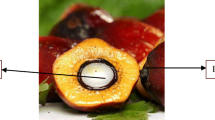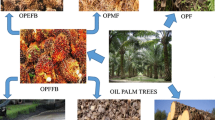Abstract
Phoenix dactylifera, which is perhaps the world’s earliest known cultivated tree, is also one of the most cultivated at present. An estimated 105 million individuals of this species are currently standing in the world, covering about 3% of the world’s cultivated area and generating about 12 million metric tonnes of waste biomass per year. The latter represents one of the biggest streams of lignocellulosic waste which is remaining largely unutilized at present for want of economically viable utilization options. This paper assesses the potential of date palm waste and reviews the attempts made so far to extract energy from it in the form of solid, liquid, and gaseous fuels. The paper underscores the need for making greater efforts towards finding gainful solutions of the date palm waste problem.
Access this chapter
Tax calculation will be finalised at checkout
Purchases are for personal use only
Similar content being viewed by others
References
Zaid, A., & de Wet, P. F. (2002). Date palm cultivation. Abdelouahhab Zaid (ed.) Chapter II, FAO Plant production and protection.
Dowson, V. H. W. (1982). Date production and protection with special reference to North Africa and the Near East. FAO Technical Bull No, 35, 294.
Chevalier, A. (1952). Recherches sur les Phoenix africains. International Journal of Applied Botany and Tropical Agriculture, 355–356.
Agoudjil, B., Benchabaneb, A., Boudennec, A., Ibos, L., & Fois, M. (2011). Renewable Materials to Reduce Building Heat Loss: Characterization of Date Palm Wood. Energy and Buildings, 43, 491–497.
El May, Y., Dorge, S., Jeguirim, M., Trouvé, G., & Said, R. (2012). Measurement of gaseous and particulate pollutants during combustion of date palm wastes for energy recovery. Aerosol and Air Quality Research, 12, 814–825.
FAO STAT (2012). Food and Agriculture Organization of the United Nations. Retrieved Dec 2012, from http://faostat.fao.org/site/339/default.aspx.
Pliny, C. (1489). The Elder. Trans. Historia Naturale, Book XIII, Cap. III, 3 columns on the palmae. Translated into Italian by Christofore Landioro Fiorentino and published by Bartolamio de Zani de Portesio.
Van Zyl, H. J. (1983). Date cultivation in South Africa. Fruit and Fruit Technology Research Institute, Department of Agriculture, Stellenbosch, RSA. Information Bulletin, 504, 26.
Soussa, A. (1969). Irrigation and civilisation in Oued Rafi din. First Part. Adib ed. Baghdad. Iraq.
Zaid, A., & Arias-Jiménez, E. J. (2002). Date palm cultivation. Food and Agricultural Organization of the United Nations, Rome. Retrieved April 2013, from http://www.fao.org/docrep/006/Y4360E/Y4360E00.HTM.
Barreveld, W. H. (1993). Date palm products. Food and Agriculture Organization of the United Nations Rome, Fao Agricultural Services Bulletin No. 101. Retrieved April, 2013, from http://www.fao.org/docrep/t0681E/t0681e00.htm.
Al-Juhaimi, F.Y., Hamand, S.H., Al-Ahaideb, I.S., Al-Otaibi, M.M., Nayeem-Shah, M., Abbasi, T., & Abbasi, S.A. (2013). An assessment of the feasibility of extracting clean energy as biogas from date palm waste, under review.
Bchini, H., Hsayoui, S., & Aloui, S. (2002). Gestion de la Matière Organique et Compostage des Palmes Sèches Dans le Milieu Oasien. Annales de l’INRAT, 75, 299–312.
Ismail, Z. Z. (2012). Kinetic study for phosphate removal from water by recycled date-palm wastes as agricultural by-products. International Journal of Environmental Studies, 69, 135–149.
Briones, R., Serrano, L., Younes, R.B., Mondragon, I., & Labidi, J. (2011). Polyol production by chemical modification of date seeds.Industrial Crops and Products, 34, 1035–1040.
Besbes, S., Blecker, C., Deroanne, C., Drira, N.-E., & Attia, H. (2004). Date seeds: Chemical composition and characteristic profiles of the lipid fraction. Food chemistry, 84, 577–584.
Al Farsi, M. A., & Lee, C. Y. (2008). Nutritional and functional properties of dates: A review. Critical Reviews in Food Science and Nutrition, 48, 877–887.
Al-Omari, S. A. B. (2006). Experimental Investigation on the Combustion and Heat Transfer Characteristics in a Furnace with Unconventional Biomass Fuels (Date Stones and Palm Stalks). Energy Conversion Management, 47, 778–790.
Al-Omari, S. A. B. (2009). Evaluation of the Biomass “Date Stones” as a Fuel in Furnaces: A Comparison with Coal Combustion. International Communication in Heat and Mass Transfer, 36, 956–961.
Sait, H. H., Hussain, A., Salema, A. A., & Ani, F. N. (2012). Pyrolysis and combustion kinetics of date palm biomass using thermogravimetric analysis. Bioresource Technology, 118, 382–389.
Abed, I., Paraschiv, M., Loubar, K., Zagrouba, F., & Tazerout, M. (2012). Thermogravimetric investigation and thermal conversion kinetics of typical North African and middle eastern lingo cellulosic wastes. BioResources, 7, 1200–1220.
Joardder, M. U. H., Uddin, M. S., & Islam, M. N. (2012). The utilization of waste date seed as bio-oil and activated carbon by pyrolysis process. Advanced Mechanical Engineering, 2012, 6 pages.
Demirbas, A. (2004). Effects of temperature and particle size on biochar yield from pyrolysis of agricultural residues. Journal of Analytical Applied Pyrolysis, 72, 243–248.
Karaosmanoglu, F., Çift, B. D., & Işigigür-Ergüdenler, A. (2001). Determination of reaction kinetics of straw and stalk of rapeseed using thermogravimetric analysis. Energy Sources, 23, 767–774.
Şensöz, S., & Can, M. (2002). Pyrolysis of pine (Pinus Brutia Ten.) chips: 1. Effect of pyrolysis temperature and heating rate on the product yields. Energy Sources, 24, 347–355.
Mansaray, K. G., & Ghaly, A. E. (1997). Physical and Thermochemical Properties of Rice Husk. Energy Sources, 19(9), 989–1004. https://doi.org/10.1080/00908319708908904.
Kastanaki, E., & Vamvuka, D. (2006). A comparative reactivity and kinetic study on the combustion of coal–biomass char blends. Fuel, 85(9), 1186–1193. https://doi.org/10.1016/j.fuel.2005.11.004.
Akasha, I. A., Campbell, L., & Euston, S. R. (2012). Extraction and characterisation of protein fraction from date palm fruit seeds. World Academy of Science, Engineering and Technology, 70.
El Maya, Y., Jeguirim, M., Dorge, S., Trouvé, G., & Said, R. (2012). Study on the thermal behavior of different date palm residues: Characterization and devolatilization kinetics under inert and oxidative atmospheres. Energy, 44, 702–709.
Sánchez-Zapata, E., Fernández-López, J., Peñaranda, M., Fuentes-Zaragoza, E., Sendra, E., Sayas, E., & Pérez-Alvarez, J. A. (2011). Technological properties of date paste obtained from date by-products and its effect on the quality of a cooked meat product. Food Research International, 44, 2401–2407.
Baliga, M. S., Baliga, B. R. V., Kandathil, S. M., Bhat, H. P., & Vayalil, P. K. (2011). A review of the chemistry and pharmacology of the date fruits (Phoenix dactylifera L.). Food Research International, 44, 1812–1822.
Bendahou, A., Dufresne, A., Kaddamai, H., & Habibi, Y. (2007). Isolation and structural characterization of hemicelluloses from palm of Pheonix dactylifera L. Carbohydrate Polymers, 68, 601–608.
Saadaoui, N., Rouilly, A., Fares, K., & Rigal, L. (2013). Characterization of date palm lignocellulosic by-products and self-bonded composite materials obtained thereof. Materials and design, 50, 302–308.
Khiari, R., Mhenni, M. F., Belgacem, M. N., & Mauret, E. (2010). Chemical composition and pulping of date palm rachis and Posidonia oceanica—A comparison with other wood and non-wood fibre sources. Bioresource Technology, 101, 775–780.
Mansaray, K. .G., & Ghaly, A. E. (1998). Thermal degradation of rice husks in nitrogen atmosphere. Bioresource Technology, 65(1–2), 13–20. https://doi.org/10.1016/S0960-8524(98)00031-5.
Várhegyi, G., Antal, M. J., Jakab, E., & Szabó, P. (1997). Kinetic modeling of biomass pyrolysis. Journal of Analytical Applied Pyrolysis , 42, 73–87.
Al-Zuhair, S., Ahmed, K., Abdulrazak, A., & El-Naas, M. H. (2013). Synergistic effect of pretreatment and hydrolysis enzymes on the production of fermentable sugars from date palm lignocellulosic waste. Journal of Industrial and Engineering Chemistry, 19, 413–415.
Anuradha, J., Abbasi, T., & Abbasi, S. A. (2015). An eco−friendly method of synthesizing gold nanoparticles using on otherwise worthless weed pistia. Journal of Advanced Research, http://doi.org/10.1016/j.jare.2014.03.006.
Abbasi, T., & Abbasi, S.A. (2012). Is the use of renewable energy sources an answer to the problems of global warming and pollution? Critical Reviews in Environmental Science and Technology (Taylor and Francis), 42, 99–154.
Abbasi, S. A. (2006). Atomic Absorption Spectrometric and Spectrophotometric Trace Analysis of Uranium in Environmental Samples with N-p-MEthoxyphenyl-2-Furylacrylohydroxamic acid and 4-(2-Pyridylazo) Resorcinol. International Journal of Environmental Analytical Chemistry, 36(3), 163–172. https://doi.org/10.1080/03067318908026869.
Abd-Alla, M. H., Morsy, F. M., & El-Enany, A. W. E. (2011). Hydrogen production from rotten dates by sequential three stages fermentation. International Journal of Hydrogen Energy, 36(21), 13518–13527.
Mehaia, M. A., & Cheryan, M. (1991). Fermentation of date extracts to ethanol and vinegar in batch and continuous membrane reactors. Enzyme and Microbial Technology, 13(3), 257–261.
Besbes, S., Drira, L., Blecker, C., Deroanne, C., & Attia, H. (2009). Adding value to hard date (Phoenix dactylifera L.): Compositional, functional and sensory characteristics of date jam. Food Chemistry, 112, 406–411.
Gupta, N., & Kushwaha, H. (2011). Date Palm as a Source of Bioethanol Producing Microorganisms. In S. M. Jain, J. M. Al-Khayri, & D. V. Johnson (Eds.), Springer (pp. 711–727). Date Palm Biotechnology.
Gaily, M. H., Sulieman, A. K., Zeinelabdeen, M. A., Al-Zahrani, S. M., Atiyeh, H. K., & Abasaeed, A. E. (2012). The effects of activation time on the production of fructose and bioethanol from date extract. African Journal of Biotechnology., 11(32), 8212–8217.
Acourene, S., & Ammouche, A. (2012). Optimization of ethanol, citric acid, and α-amylase production from date wastes by strains of Saccharomyces cerevisiae, Aspergillus niger, and Candida guilliermondii. Journal of Industrial Microbiology and Biotechnology, 39(5), 759–766.
Abd-Alla, M. H., & El-Enany, A. W. E. (2012). Production of acetone-butanol-ethanol from spoilage date palm (Phoenix dactylifera L.) fruits by mixed culture of Clostridium acetobutylicum and Bacillus subtilis. Biomass and Bioenergy, 42, 172–178.
Khamaiseh, E. I., Kalil, M. S., Dada, O., El-Shawabkeh, I., & Yusoff, W. M. W. (2012). Date fruit as carbon source in RCM-Modified medium to produce biobutanol by Clostridium acetobutylicum NCIMB 13357. Journal of Applied Sciences, 12(11), 1160–1165.
Ahmadi, F., Rad, A. R., Holtzapple, M. T., & Zamiri, M. J. (2012). Short-term oxidative lime pre-treatment of palm pruning waste for use as animal feedstuff. Journal of the Science of Food and Agriculture, Article in press.
Bamufleh, H. S., Alhamed, Y. A., & Daous, M. A. (2013). Furfural from midribs of date-palm trees by sulfuric acid hydrolysis. Industrial Crops and Products, 42, 421–428.
Baroon, Z., El-Nawawy, A. S., & Al-Othman, A. (2004). Ensilage of Cardboard and Date Palm Leaves. Journal of Environmental Science and Health—Part A Toxic/Hazardous Substances and Environmental Engineering, 39, 515–533.
Chandrasekaran, M., & Bahkali, A. H. (2013). Valorization of date palm (Phoenix dactylifera) fruit processing by-products and wastes using bioprocess technology—Review. Saudi Journal of Biological Sciences. Article in press.
Devshony, S., Eteshola, A., & Shani, A. (1992). Characterisation and some potential application of date palm (Phoenix dactylifera L.) seeds and seeds oil. Bioresource Technology, 67, 291–295.
Ghehsareh, A. M., Samadi, N., & Borji, H. (2011). Comparison of date-palm wastes and perlite as growth substrates on some tomato growing indexes. African Journal of Biotechnology, 10(24), 4871–4878.
Ghosh, S. K., Sengupta, S., & Naskar, M. (2010). Physio-mechanical properties of particle boards from agro-wastes. Journal of Scientific and Industrial Research, 69(5), 396–400.
Ramzi, K., Nizar, M., Farouk, M., Naceur, B. M., & Evelyne, M. (2011). Sodium carboxylmethylate cellulose from date palm rachis as a sizing agent for cotton yarn. Fibers and Polymers, 12(5), 587–593.
Tavakkoli, M., Hamidi-Esfahani, Z., & Azizi, M. H. (2009). Optimization of Corynebacterium glutamicum Glutamic acid production by response surface methodology. Food and Bioprocess Technology, 1–8.
Acknowledgements
SAA thanks Indian National Science Academy [INSA], New Delhi, and PP thanks Council for Scientific and Industrial Research [CSIR], New Delhi, for support.
Author information
Authors and Affiliations
Editor information
Editors and Affiliations
Rights and permissions
Copyright information
© 2022 The Author(s), under exclusive license to Springer Nature Singapore Pte Ltd.
About this paper
Cite this paper
Tabassum-Abbasi, Nayeem-Shah, M., Abbasi, S.A., Abbasi, T. (2022). Date Palm Waste and Attempts to Use it as an Energy Source: State-of-the-Art. In: Siddiqui, N.A., Khan, F., Tauseef, S.M., Ghanem, W.S., Garaniya, V. (eds) Advances in Behavioral Based Safety. Springer, Singapore. https://doi.org/10.1007/978-981-16-8270-4_3
Download citation
DOI: https://doi.org/10.1007/978-981-16-8270-4_3
Published:
Publisher Name: Springer, Singapore
Print ISBN: 978-981-16-8269-8
Online ISBN: 978-981-16-8270-4
eBook Packages: EngineeringEngineering (R0)




